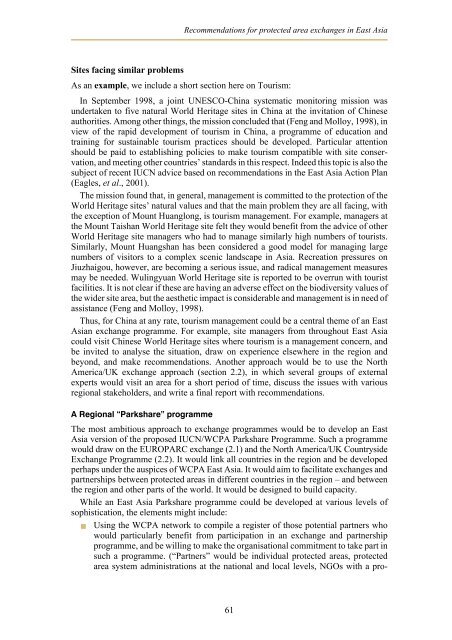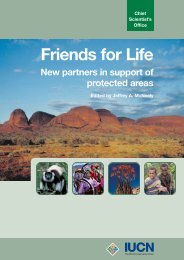Exchange programmes - IUCN
Exchange programmes - IUCN
Exchange programmes - IUCN
Create successful ePaper yourself
Turn your PDF publications into a flip-book with our unique Google optimized e-Paper software.
Sites facing similar problems<br />
As an example, we include a short section here on Tourism:<br />
In September 1998, a joint UNESCO-China systematic monitoring mission was<br />
undertaken to five natural World Heritage sites in China at the invitation of Chinese<br />
authorities. Among other things, the mission concluded that (Feng and Molloy, 1998), in<br />
view of the rapid development of tourism in China, a programme of education and<br />
training for sustainable tourism practices should be developed. Particular attention<br />
should be paid to establishing policies to make tourism compatible with site conservation,<br />
and meeting other countries’ standards in this respect. Indeed this topic is also the<br />
subject of recent <strong>IUCN</strong> advice based on recommendations in the East Asia Action Plan<br />
(Eagles, et al., 2001).<br />
The mission found that, in general, management is committed to the protection of the<br />
World Heritage sites’ natural values and that the main problem they are all facing, with<br />
the exception of Mount Huanglong, is tourism management. For example, managers at<br />
the Mount Taishan World Heritage site felt they would benefit from the advice of other<br />
World Heritage site managers who had to manage similarly high numbers of tourists.<br />
Similarly, Mount Huangshan has been considered a good model for managing large<br />
numbers of visitors to a complex scenic landscape in Asia. Recreation pressures on<br />
Jiuzhaigou, however, are becoming a serious issue, and radical management measures<br />
may be needed. Wulingyuan World Heritage site is reported to be overrun with tourist<br />
facilities. It is not clear if these are having an adverse effect on the biodiversity values of<br />
the wider site area, but the aesthetic impact is considerable and management is in need of<br />
assistance (Feng and Molloy, 1998).<br />
Thus, for China at any rate, tourism management could be a central theme of an East<br />
Asian exchange programme. For example, site managers from throughout East Asia<br />
could visit Chinese World Heritage sites where tourism is a management concern, and<br />
be invited to analyse the situation, draw on experience elsewhere in the region and<br />
beyond, and make recommendations. Another approach would be to use the North<br />
America/UK exchange approach (section 2.2), in which several groups of external<br />
experts would visit an area for a short period of time, discuss the issues with various<br />
regional stakeholders, and write a final report with recommendations.<br />
A Regional “Parkshare” programme<br />
Recommendations for protected area exchanges in East Asia<br />
The most ambitious approach to exchange <strong>programmes</strong> would be to develop an East<br />
Asia version of the proposed <strong>IUCN</strong>/WCPA Parkshare Programme. Such a programme<br />
would draw on the EUROPARC exchange (2.1) and the North America/UK Countryside<br />
<strong>Exchange</strong> Programme (2.2). It would link all countries in the region and be developed<br />
perhaps under the auspices of WCPA East Asia. It would aim to facilitate exchanges and<br />
partnerships between protected areas in different countries in the region – and between<br />
the region and other parts of the world. It would be designed to build capacity.<br />
While an East Asia Parkshare programme could be developed at various levels of<br />
sophistication, the elements might include:<br />
� Using the WCPA network to compile a register of those potential partners who<br />
would particularly benefit from participation in an exchange and partnership<br />
programme, and be willing to make the organisational commitment to take part in<br />
such a programme. (“Partners” would be individual protected areas, protected<br />
area system administrations at the national and local levels, NGOs with a pro-<br />
61






